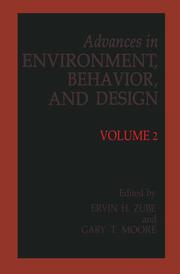-
Zusatztext
-
This second volume in the Advances in Environment, Behavior, and Design series follows the pattern of Volume 1. It is organized into six sections user group research, consisting of advances in theory, place research, sociobehavioral research, research and design methods, and research utilization. The authors of the chapters in this volume represent a range of disciplines, including architecture, geography, psychology, social ecology, and urban planning. They also offer international perspectives: Tommy Garling from Sweden, Graeme Hardie from South Africa (re cently relocated to North Carolina), Gerhard Kaminski from the Federal Republic of Germany, and Roderick Lawrence from Switzerland (for merly from Australia). Although most chapters address topics or issues that are likely to be familiar to readers (environmental perception and cognition, facility pro gramming, and environmental evaluation), four chapters address what the editors perceive to be new topics for environment, behavior, and design research. Herbert Schroeder reports on advances in research on urban for estry. For most of us the term forest probably conjures up visions of dense woodlands in rural or wild settings. Nevertheless, in many parts of the country, urban areas have higher densities of tree coverage than can be found in surrounding rural landscapes. Schroeder reviews re search that addresses the perceived and actual benefits and costs associ ated with these urban forests.
-
-
Kurztext
-
InhaltsangabeI Advances in Theory.- 1 The Relevance of Ecologically Oriented Theory Building in Environment and Behavior Research.- What Is Meant by Ecological?.- Problems of Theory Development in the Environment-Behavior Research-and-Design Field.- Classes and Functions of Theoretical Structures.- Tracing the Background of Theory Deficit.- A Descriptive Taxonomy of Domain Components.- Specific Contributions of the Two Main Ecological Approaches to Conceptualizing the Environment-Behavior Field.- Barker's Ecobehavioral Approach.- Gibson's Ecological Approach.- Further Developments of Barker's Ecobehavioral Perspective and Their Theoretical Implications.- Modifications of the Conceptual Unit "Behavior Setting".- Changes in the Embedding of the Behavior-Setting Unit.- Development of Classifications and Taxonomic Dimensions for Behavior Settings.- Consideration of the Individual's Relatedness to Behavior Settings.- "Psychologization" of the Behavior Setting and Its Occupants.- Longitudinal Perspectives on Behavior-Setting Changes.- Empirical Exemplification, Application, and Validation of Behavior-Setting-Related Hypotheses.- Implications for Future Research and Application.- References.- 2 Structuralist Theories in Environment-Behavior-Design Research: Applications for Analyses of People and the Built Environment.- What Is Structuralism?.- Global Structuralism.- Analytical Structuralism.- Structuralist Interpretations.- Structuralism and Human Cognition: The Contribution of Levi-Strauss.- Structuralism and Marxism: The Contribution of Castells.- Applications to Studies of the Built Environment and Human Behavior.- The Syntax of the Built Environment.- Architectural Semiotics.- Redefinition of Structuralist Theory and Methods.- Toward a Definition of Dialectical Structuralism.- A Structural, Historical, and Cross-Cultural Analysis of Homes.- Implication for Future Research and Application.- References.- 3 Notes on Theory in Environment and Behavior Research.- Folk Theories.- Scientific Theories.- Relevance of Scientific Theories.- Relevance: Success and Utility.- Contact between Scientific and Folk Theories.- The Acceptance of Theories.- Environment-Behavior-Design Theory: What For?.- References.- II Advances in Place Research.- 4 Environment, Behavior, and Design Research on Urban Forests.- Major Research Topics.- Benefits and Values Associated with Urban Forests.- Perception of Urban Forest Environments.- On-Site Behavior in Urban Forests.- Destination Choice Behavior.- Safety, Crime, and Conflict.- Sources of Variation in Preference and Behavior.- Application of Research to Management Systems.- Implications for Future Research and Application.- References.- 5 Environment and Behavior Research for Developing Countries.- The Context of Developing Countries.- Housing: The Primary Focus of Environment-Behavior Research in Developing Countries.- House Design.- Housing Technology and Infrastructure.- Participation and Housing.- Housing Policy.- Fieldwork Techniques.- Physical Baseline Surveys.- Structured Interviews.- Open-Ended In-Depth Interviews.- Group Discussions.- Walk-About Verbal Descriptions.- Simulation and Projective Techniques.- Participant Observation.- Implications for Future Research and Application.- References.- III Advances in User Group Research.- 6 Hospital Design, Health Providers, and the Delivery of Effective Health Care.- The Sociophysical Environment and Patient Care.- Implicit Models.- Limits of Empirical Studies of Hospital Settings.- The Evolution of Hospital Design.- Historical Origins of Hospitals.- Current Factors Influencing Hospital Design.- The Hospital Design Process.- Humanizing Hospital Space.- Choosing the User Group to Optimize Change.- Patient-Based Design Interventions.- Health-Provider-Based Design Interventions.- Hospital Design and Nursing Care.- The Sociophysical Environment and Nurses.- Nurses and Patients in Hospital Settings.- Modeling the Effects of the Sociophysical Environment on the Delivery of
-
Detailansicht
Advances in Environment, Behavior and Design
Volume 2, Advances in Environment, Behavior and Design 2
ISBN/EAN: 9781461280477
Umbreit-Nr.: 6588917
Sprache:
Englisch
Umfang: xvi, 366 S., 47 s/w Illustr., 366 p. 47 illus.
Format in cm:
Einband:
kartoniertes Buch
Erschienen am 23.09.2011
Auflage: 1/2011


